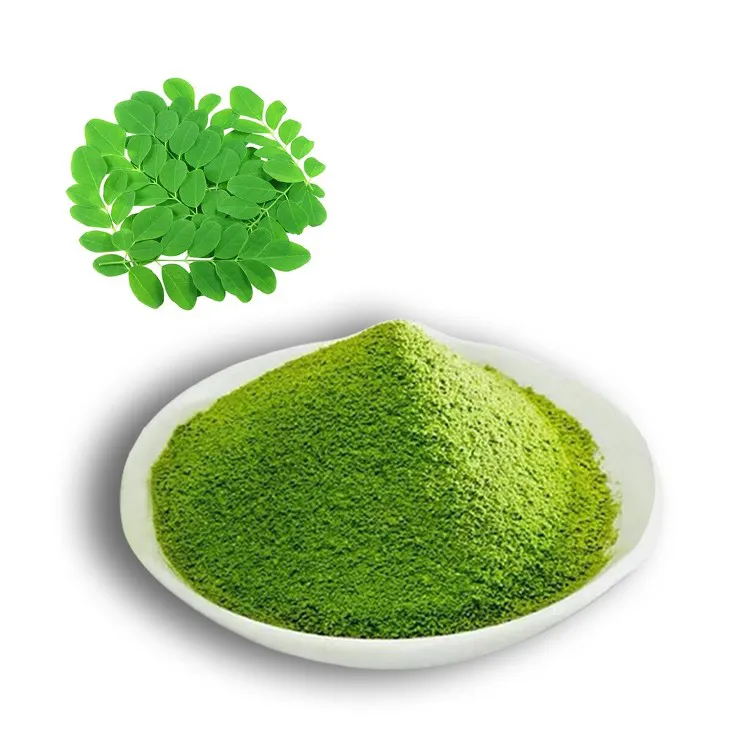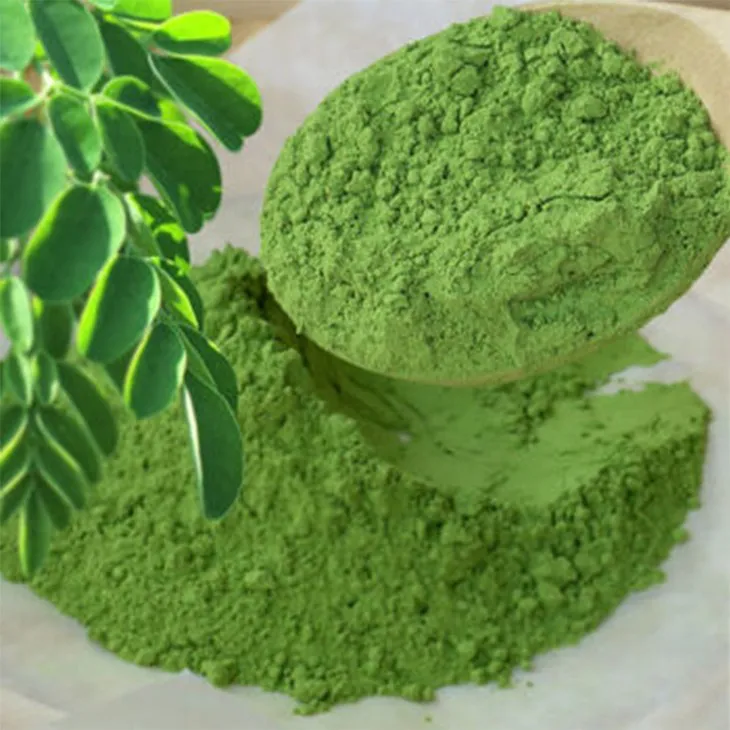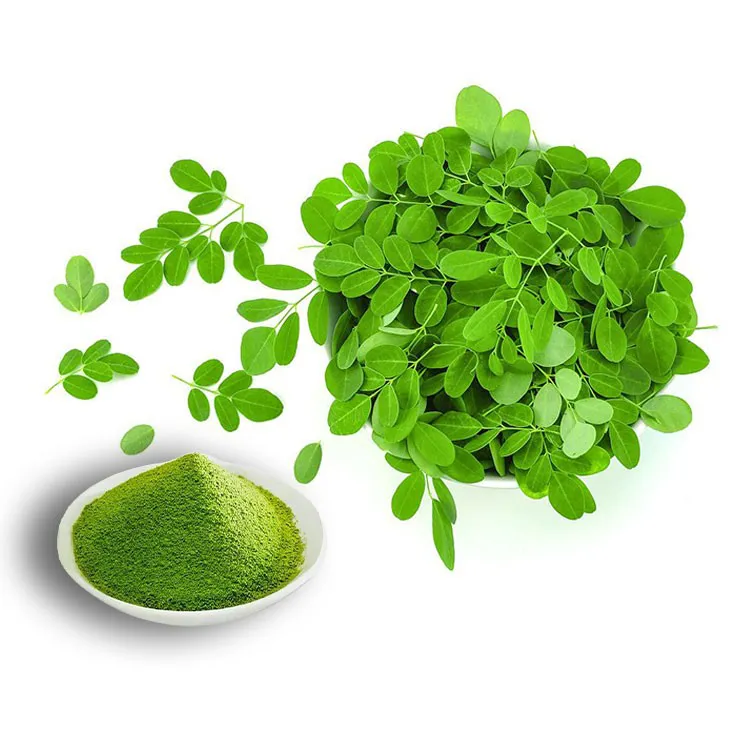- 0086-571-85302990
- sales@greenskybio.com
Moringa powder: from leaves to extraction.
2024-11-13

1. Introduction to Moringa Leaves
Moringa, also known as the "miracle tree," has been a subject of great interest in recent years, especially when it comes to its leaves. Moringa leaves are rich in a variety of nutrients, which makes them highly valuable in the fields of health and nutrition.
These leaves are typically small to medium - sized, with a green color that is characteristic of healthy foliage. They are often oval - shaped, with a smooth texture. Moringa trees are native to parts of South Asia, but they are now cultivated in many tropical and subtropical regions around the world. This wide - spread cultivation is due to the increasing demand for moringa products, especially Moringa powder.

2. Sourcing of Moringa Leaves
2.1. Cultivation Areas
As mentioned, moringa trees are native to South Asia, including countries like India, Pakistan, and Nepal. In India, for example, moringa has been a part of traditional medicine and cuisine for centuries. However, today, moringa is also grown in Africa, South America, and Southeast Asia.
In Africa, countries such as Kenya, Tanzania, and Malawi have large - scale moringa plantations. The climate in these regions, which is often warm and semi - arid, is suitable for moringa growth. The trees can tolerate a certain degree of drought, which makes them a viable crop in areas with limited water resources.
2.2. Harvesting Methods
Moringa leaves are usually harvested by hand. This is because the leaves are delicate, and mechanical harvesting may damage them. The timing of the harvest is crucial. Generally, the leaves are harvested when they are young and tender, as this is when they have the highest nutrient content.
- Harvesters carefully pick the leaves from the branches, often early in the morning when the leaves are fresh and full of moisture.
- They avoid harvesting leaves that are yellowing or damaged, as these may have a lower nutrient value.
2.3. Quality Control at the Source
Once the leaves are harvested, quality control measures are implemented at the source. This includes checking for any signs of pests or diseases. Leaves that are infested with pests or affected by diseases are removed immediately.
- The harvested leaves are also sorted based on their size and quality. Larger, intact leaves are often preferred as they are easier to process.
- Sampling is done to test the nutrient content of the leaves. This ensures that only high - quality leaves are sent for further processing.

3. Processing of Moringa Leaves into Powder
3.1. Cleaning and Washing
The first step in processing moringa leaves into powder is cleaning and washing. The freshly harvested leaves are carefully washed to remove any dirt, debris, or insects that may be present on them.
- This is usually done using clean water. The leaves are gently agitated in water to ensure that all impurities are removed.
- After washing, the leaves are drained to remove excess water. This is important as too much water can affect the subsequent drying process.
3.2. Drying
Drying is a critical step in the process of making Moringa powder. There are different methods of drying moringa leaves.
- Sun - drying: This is a traditional method. The washed leaves are spread out in a thin layer on clean trays or mats and placed in a sunny location. The leaves need to be turned regularly to ensure even drying. However, sun - drying may take longer and is dependent on the weather conditions.
- Dehydrator - drying: Using a dehydrator is a more controlled method. The dehydrator can be set to a specific temperature and humidity level. This method is faster than sun - drying and can produce more consistent results. The leaves are placed in the dehydrator trays, and the drying process is monitored until the leaves are completely dry.
- Oven - drying: In some cases, an oven can be used for drying. The oven is set to a low temperature (usually around 40 - 50°C) to avoid burning the leaves. Similar to the dehydrator, the leaves are placed on trays and dried until they are brittle.
3.3. Grinding
Once the leaves are completely dry, they are ready for grinding. The dried leaves are ground into a fine powder using a grinder.
- High - quality grinders are used to ensure that the powder is fine and uniform. A coarse powder may not dissolve well in liquids or may have an unpleasant texture.
- The grinding process needs to be carefully monitored to prevent over - grinding, which can cause the powder to heat up and lose some of its nutrients.

4. Extraction Methods in Moringa powder Production
4.1. Cold - Press Extraction
Cold - press extraction is one of the methods used in the production of moringa powder. This method involves pressing the dried moringa leaves or other parts of the moringa plant (such as seeds) at a low temperature.
- The advantage of cold - press extraction is that it helps to preserve the natural nutrients and bioactive compounds in moringa. Since the process is carried out at a low temperature, there is less degradation of heat - sensitive substances.
- However, cold - press extraction may not be as efficient as some other methods in terms of extracting all the available compounds. It may also require more time and energy.
4.2. Solvent - Based Extraction
Solvent - based extraction is another common method. In this process, a solvent is used to extract the desired compounds from the moringa leaves.
- Common solvents used include ethanol or water - ethanol mixtures. These solvents are able to dissolve a wide range of compounds present in the moringa leaves, such as vitamins, minerals, and phytochemicals.
- The disadvantage of solvent - based extraction is that there is a need to remove the solvent completely from the final product. Any residual solvent in the moringa powder can be harmful if consumed.
4.3. Supercritical Fluid Extraction
Supercritical fluid extraction is a more advanced method. It uses a supercritical fluid, such as carbon dioxide, as the extraction medium.
- Carbon dioxide in its supercritical state has properties that are similar to both a gas and a liquid. It can penetrate the plant material easily and selectively extract the desired compounds. This method is very efficient in extracting high - value compounds from moringa leaves while maintaining their quality and purity.
- However, supercritical fluid extraction requires specialized equipment, which is expensive. This makes it less accessible for small - scale producers.
5. Nutritional Value of Moringa Powder
Moringa powder is rich in a variety of nutrients, which is why it has gained so much popularity in the health and nutrition fields.
- Vitamins: Moringa powder contains vitamins such as vitamin A, vitamin C, vitamin E, and various B - vitamins. Vitamin A is important for eye health, while vitamin C is an antioxidant that helps boost the immune system. Vitamin E also has antioxidant properties, and B - vitamins are involved in energy metabolism.
- Minerals: It is a good source of minerals like calcium, potassium, iron, and magnesium. Calcium is essential for bone health, potassium helps regulate blood pressure, iron is necessary for oxygen transport in the body, and magnesium is involved in many biochemical reactions.
- Protein: Moringa powder contains a significant amount of protein. This makes it a valuable addition for vegetarians and vegans who may have difficulty getting enough protein from other sources.
- Phytochemicals: There are also numerous phytochemicals in moringa powder, such as flavonoids and phenolic compounds. These phytochemicals have antioxidant, anti - inflammatory, and other beneficial properties.
6. Applications of Moringa Powder in Health and Nutrition
Due to its rich nutritional profile, moringa powder has a wide range of applications in health and nutrition.
- Immune System Support: The vitamins and phytochemicals in moringa powder can help boost the immune system. Regular consumption may reduce the risk of getting sick and help the body recover more quickly from illness.
- Digestive Health: Moringa powder can aid in digestion. It may help improve bowel regularity and relieve constipation. Some of the compounds in moringa powder can also stimulate the growth of beneficial gut bacteria.
- Energy Booster: With its protein and B - vitamins, moringa powder can provide a natural energy boost. It can be a great alternative to sugary energy drinks or caffeinated beverages.
- Skin Health: The antioxidants in moringa powder can help protect the skin from damage caused by free radicals. It may also help improve skin complexion and reduce the signs of aging.
7. Conclusion
Moringa powder, which is derived from moringa leaves through a series of processes including sourcing, processing, and extraction, is a highly valuable natural product. Its journey from the leaves to the final powder form is carefully orchestrated to preserve its rich nutritional content.
Understanding how moringa leaves are sourced and processed into powder not only helps us appreciate the value of this product but also enables us to make more informed decisions about its use in health, nutrition, and other applications. As research on moringa continues, we can expect to see even more potential uses and benefits of this "miracle powder" in the future.
FAQ:
Question 1: Where are the moringa leaves typically sourced from?
Moringa leaves are mainly sourced from regions where the moringa tree grows well. These regions include parts of Africa, Asia, and South America. The tree is well - adapted to tropical and subtropical climates. In Africa, countries like Kenya and Tanzania are major sources. In Asia, India is a significant contributor as the moringa tree has been cultivated there for a long time. The leaves are carefully harvested from these natural or cultivated sources for further processing.
Question 2: How are the moringa leaves harvested?
The harvesting of moringa leaves is a delicate process. Usually, the young and tender leaves are preferred as they contain higher nutrient levels. Workers carefully pick the leaves by hand to avoid damaging the tree. This is often done during the appropriate growth stage of the tree, typically when the leaves are at their peak in terms of nutritional content. The harvested leaves are then collected and prepared for the next stage of processing.
Question 3: What is the extraction process to turn moringa leaves into powder?
First, the freshly harvested moringa leaves are thoroughly washed to remove any dirt, debris, or insects. Then, they are dried. Drying can be done through natural sunlight drying or in a controlled - environment dryer. Once dried, the leaves are ground into a fine powder. This can be achieved using mechanical grinders. Some extraction methods may also involve separating out certain components or concentrating specific nutrients during the grinding process to enhance the quality of the moringa powder.
Question 4: What are the main nutrients in moringa powder?
Moringa powder is rich in various nutrients. It contains a significant amount of vitamins such as vitamin A, vitamin C, and vitamin E. It also has essential minerals like calcium, potassium, and iron. Additionally, moringa powder is a good source of proteins, amino acids, and antioxidants. These nutrients contribute to its popularity in the fields of health and nutrition.
Question 5: How can we ensure the quality of moringa powder during the extraction process?
To ensure the quality of moringa powder during extraction, several steps are crucial. Firstly, starting with high - quality, fresh leaves is essential. The drying process should be carefully controlled to prevent spoilage or nutrient loss. Using clean and well - maintained equipment for grinding and extraction helps maintain purity. Quality control checks at different stages of the process, such as testing for moisture content, nutrient levels, and absence of contaminants, are also necessary. Additionally, following good manufacturing practices and adhering to relevant food safety standards ensure the production of high - quality moringa powder.
Related literature
- Moringa oleifera: A Review of Its Nutritional and Medicinal Properties"
- "The Potential of Moringa oleifera Leaf Extracts in Nutraceutical and Pharmaceutical Applications"
- "Processing and Utilization of Moringa oleifera: A Multifunctional Tree"
- ▶ Hesperidin
- ▶ Citrus Bioflavonoids
- ▶ Plant Extract
- ▶ lycopene
- ▶ Diosmin
- ▶ Grape seed extract
- ▶ Sea buckthorn Juice Powder
- ▶ Fruit Juice Powder
- ▶ Hops Extract
- ▶ Artichoke Extract
- ▶ Mushroom extract
- ▶ Astaxanthin
- ▶ Green Tea Extract
- ▶ Curcumin
- ▶ Horse Chestnut Extract
- ▶ Other Product
- ▶ Boswellia Serrata Extract
- ▶ Resveratrol
- ▶ Marigold Extract
- ▶ Grape Leaf Extract
- ▶ New Product
- ▶ Aminolevulinic acid
- ▶ Cranberry Extract
- ▶ Red Yeast Rice
- ▶ Red Wine Extract
-
Buckthorn bark extract
2024-11-13
-
Avocado Extract Powder
2024-11-13
-
Centella Asiatica Extract
2024-11-13
-
White Peony Extract
2024-11-13
-
Polygonum Cuspidatum Extract
2024-11-13
-
Reishi mushroom extract
2024-11-13
-
Uridine-5'-monophosphate Disodium salt
2024-11-13
-
Pueraria Lobata Extract
2024-11-13
-
Genistein
2024-11-13
-
Konjac Powder
2024-11-13





















